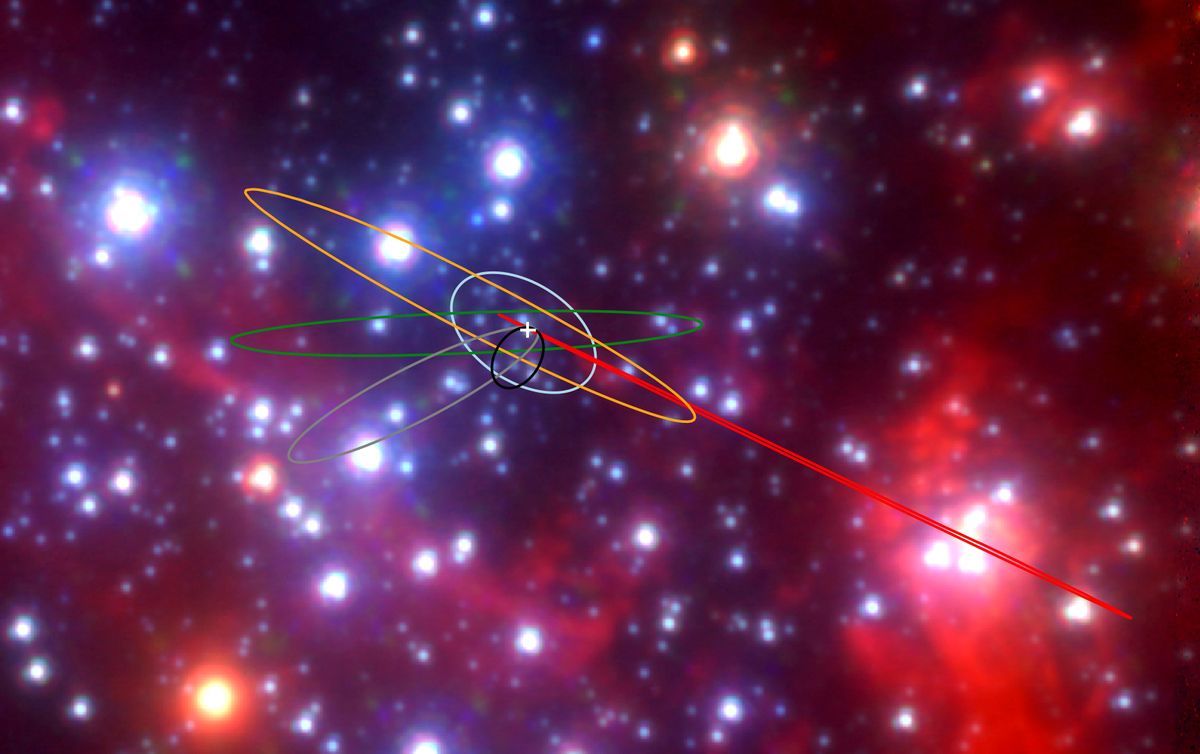The Black Hole at the Center of the Galaxy Is Forging a Strange New Kind of Star
The black hole at the center of our galaxy is warping and combining stars into a strange new kind of object, astronomers say.

Like most large galaxies, the Milky Way is glued together by a supermassive black hole at its center, buried deep in the constellation Sagittarius. Our galaxy's supermassive black hole, called Sagittarius A* (or Sgr A*), constantly pulls stars, dust and other matter inward, forming a stellar megalopolis 1 billion times denser than our corner of the galaxy.
Sometimes, stars closest to the black hole have to compete for space — and sometimes, a new study suggests, this competition becomes a strange and violent marriage.
In the new study, published today (Jan. 15) in the journal Nature, astronomers describe six mysterious objects swirling around our galaxy's central black hole. According to the authors, these anomalous objects (dubbed G1 through G6) look like oblong blobs of gas several times more massive than Earth. However, they behave like small stars capable of passing perilously close to the black hole’s edge without being ripped to shreds.
Related: 11 Fascinating Facts About Our Milky Way Galaxy
Are these peculiar space burps just gas, or are they stars? According to the study authors, the blobs may be a strange hybrid of both. Based on the six objects' shapes, orbits and interactions with Sgr A*, the researchers suggest that each G object is a pair of binary stars (two stars that revolve around each other) that got smashed together by the black hole's gravity millions of years ago and is still spilling out clouds of gas and dust in the messy aftermath of the collision.
"Black holes may be driving binary stars to merge," study co-author Andrea Ghez, a professor of astrophysics at the University of California, Los Angeles, said in a statement. "It's possible that many of the stars we've been watching and not understanding may be the end product of [these] mergers."
Wanderers of the void
The first two G objects were discovered in 2005 and 2012, respectively. Because the two objects followed a strikingly similar orbit around Sgr A*, some astronomers interpreted them as wisps of gas ripped away from an unfortunate dead star, or as clumped-up "knots" in a continuous ring of gas swirling around the hole.
Sign up for the Live Science daily newsletter now
Get the world’s most fascinating discoveries delivered straight to your inbox.
The first big clue that something else was going on came in 2014, when the blob called G2 came within a few hundred astronomical units (a few hundred times the average distance between Earth and the sun) of the black hole's event horizon. Astronomers predicted that, if G2 was just a cloud of gas, it would be torn to shreds by the intense gravity. But the blob survived — albeit a little misshapen.
"At the time of closest approach, G2 had a really strange signature," Ghez said. "It went from being a pretty innocuous object when it was far from the black hole to one that was really stretched out and distorted at its closest approach."
In the years after the encounter, G2 became more compact again. All of this suggested that something gravitationally powerful is holding the blob together — meaning it is likely a star of some sort, the authors wrote.
New blobs on the block
To test this hypothesis, the study authors spent several years scouring the galaxy's center from the W.M. Keck Observatory in Hawaii, searching for more potential G-type objects. The team identified four new blobs that fit the bill, each one following a wildly different orbital path around Sgr A* but showing similar characteristics as G1 and G2. The new objects look like compact clouds of gas most of the time, the researchers said, but when their orbits (which range from 100 to 1,000 years) bring them closest to the black hole, they become warped and elongated, just as G2 did.
Because each object follows a unique orbit, the theory that all of these blobs are knots of gas riding a single wheel of matter around the hole doesn't hold up. The likeliest explanation, the authors wrote, is that the G blobs are the products of binary stars that got smooshed together by the black hole's gravity — an explosive merger that can stain the sky with gas and infrared radiation.
The number of observed G-type objects fits with the expected percentage of binary stars in the central hub of the galaxy, the authors wrote. Further, because stars take about 1 million years to merge, the objects may well have been born during the last known star formation event near Sgr A*, which took place about 5 million years ago.
While the explanation seems to fit, researchers can't be certain until they locate and study more binary stars that seem to have been thrown together by a black hole. It might not take another eight years to find them — the study authors said they already have a few nearby candidates in mind, which they will continue to observe.
- 9 Epic Space Discoveries You Probably Missed in 2019
- The 15 Weirdest Galaxies in Our Universe
- The 12 Strangest Objects in the Universe
Originally published on Live Science.

Brandon is the space/physics editor at Live Science. His writing has appeared in The Washington Post, Reader's Digest, CBS.com, the Richard Dawkins Foundation website and other outlets. He holds a bachelor's degree in creative writing from the University of Arizona, with minors in journalism and media arts. He enjoys writing most about space, geoscience and the mysteries of the universe.









